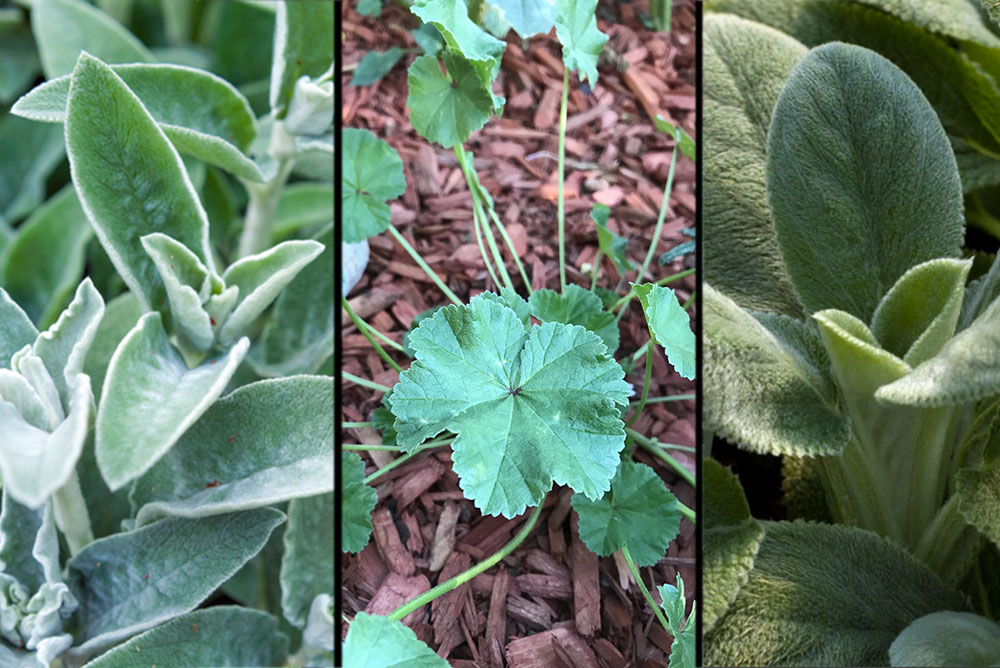
Good in a pinch, or a poop: from left, leaves of woolly lamb’s ear, mallow and mullein.
YOU THINK you have toilet paper trauma?
“It’s been a while since I thought about wiping my ass with leaves,” an ex-military pilot mused the other day.
He’s been through SERE training—an acronym for Survival, Evasion, Resistance and Escape—a course offered to high-risk soldiers, much of it hush-hush, top secret.
Therefore, we shall call him Adam. As in: You think there was toilet paper in the Garden of Eden?
During SERE training, pilots, who are among those most likely to be shot down and captured by whichever enemy we might have at the moment, are sent into the woods with a meager backpack of essentials. They spend two weeks on their own, sleeping outdoors and foraging for food—which includes killing bunnies, which is neither here nor there, but Adam is a first-rate grill chef.
As what goes in must come out, “we were in the field with a pack of wipes, which were gone in a night or two,” he told me. They were advised to use whatever came to hand, plants being an obvious choice, but with a caveat. “We had been shown a PowerPoint with pictures of what not to use, poison ivy being the big one. But inevitably plenty of soldiers who wiped with the wrong leaves ended up in the sick bay.”
Luckily, they were sent off with plenty of panties and socks, which Adam used for his toilette and then discarded. Lightening his load in more ways than one.
Unless you’ve been in SERE training for the last few weeks, you’re probably aware of the toilet-paper-hoarding pandemic—and yes, it is an international crisis.
My British friend Maggie sent me a link to an article in the UK’s Daily Mail which reported on a woman so frustrated at not being able to find toilet paper that she made her own.
A variation on the socks and panties method, she cuts microfiber cloths into quarters, which are deposited in a bucket after use and then washed in something called Napisan, which presumably has something to do with dirty diapers.
Meanwhile, another UK newspaper, The Guardian, reported that “consumers have been warned of the dangers of substituting kitchen roll and wet wipes for toilet paper which—if flushed down the loo—could overwhelm the UK’s sewers.”
The corona-related TP shortage in Australia is so bad that NT News, a tabloid in the country’s Northern Territory, added extra blank sheets for use if readers run dry.
Now. A brief history of toilet paper.
All sorts of stuffs have been used over the millennia for cleaning oneself. The website mentalfloss.com says, “The most common solution was simply to grab what was [available]: coconuts, shells, snow, moss, hay, leaves, grass, corncobs, sheep’s wool, and later—thanks to the printing press—newspapers, magazines, and pages of books.”
The Sears Roebuck catalogue, as you probably know, was extremely popular in the outhouse.
The first commercially available toilet paper, or in this case papers, were flat, aloe-infused hemp sheets invented in 1857 by Joseph Gayetty. Clearly ahead of his time with the logo trend, each sheet was watermarked with his name.
They were not widely distributed.
The Scott brothers’ TP on a roll came along in 1890, around the time that indoor plumbing become more common, as coconuts and corncobs do not flush well.
Marketed as a medicinal item, and an embarrassing one to purchase, toilet paper didn’t become a bathroom fixture for another 40 years. In 1928, Charmin started selling four-packs of “toilet tissue” with the silhouette of a glamorous woman’s face above the words “so very soft.”
That the packages also mentioned you could use the paper to remove cold cream was a helpful salve for the shy.
Thus, toilet paper took off.
Back to the present.
As this is a gardening column, we have some plant materials that make excellent substitutes. Baby sent me a graphic the other day labeled Leaves to Use in a Toilet Paper Crises. Sadly, I can’t give credit to the great mind that came up with this as it’s one of those viral messages that turn up everywhere.
There’s Mullen, which is said to be “absorbent, soft, thick and durable,” and is also useful as a lung tonic; Mallow, which is “durable, soft, and pliable, and has, it’s said, erotic uses; and Lamb’s Ear, which is “silky soft, durable, and luxurious.”
Lamb’s Ear, which I personally felt yesterday in a neighbor’s garden, has lovely soft and spongy leaves that reminded me of Ultra Soft Charmin, truly the caviar of toilet tissue.
Any of these can be grown in a pot beside the “pot,” though a grow light might be helpful. I’m not sure about the flushability, but we need to support plumbers in this time of crisis.
At the moment, you can also buy them online, along with containers and soil, thereby avoiding contamination by, you know, strangers.
But then, you could permanently avoid the entire tissue issue and install one of architect Philippe Starck’s SensoWash1 toilets, which combine washing and drying, have heated seats, and are controlled by smartphones.
At $6,700 it’s like buying a $120,000 Tesla S to save on gas, but no toilet paper is needed at all.
—Stephanie Cavanaugh
LittleBird “Stephanie Gardens” acknowledges a preference for paper over greenery.

eeeeeek!
Awwwwww Maggie, you make me flush.
This is an eerie reminder of 40 years ago… my son was 13, his nose was running while waiting with his dad at a football practice…. his dad told him to use leaves to blow his nose… yep, was poison ivy. Within hours his face blew up, trip to the ER, steroids and missed 2 weeks of school, a nightmare for a 7th grader .
What a blast! This is a “bummer” of a day – in the best possible way. Such a joy to get it started with a bottomless (not) load of laughs….